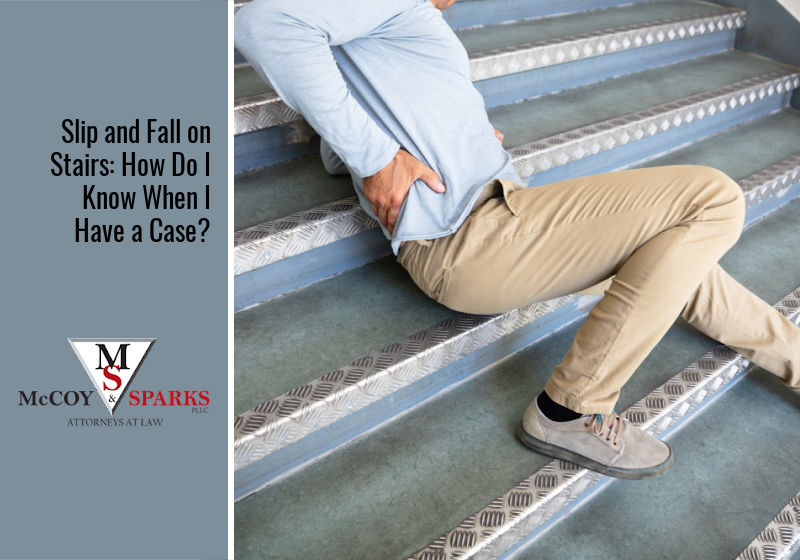
Slip and fall accidents can lead to serious or even fatal injuries, and these falls are even more dangerous when they occur on stairways. If you fall on stairs, you run the risk of suffering from repeated impact injuries as you descend. These falls are also higher from the ground, meaning that you’re likely to suffer more devastating injuries.
If you experience a slip and fall injury caused by another person’s negligence, you need to hold them accountable. Stairway slip and fall accidents can lead to injuries that require expensive medical treatment, and these injuries can also cause permanent physical limitations, decreasing your quality of life and negatively impacting your ability to work. Here’s what you need to know about injuries from a slip and fall on stairs.
Stairway Injury Statistics
Stairway injuries are incredibly common in the United States. The American Journal of Emergency Medicine published data indicating that over 1 million Americans go to the emergency room because of stairway-related injuries every single year, not to mention all of the stairway injuries that occur that don’t require a visit to the emergency room.
Young children and elderly individuals are more likely to suffer from stairway-related injuries, but anyone can suffer life-threatening injuries from a slip and fall on stairs. Some common stairway-related injuries include:
- Sprains and strains: The American Journal of Emergency Medicine’s data indicated sprains and strains make up 32.3% of all stairway injuries.
- Soft tissue injuries: Data indicated that 23.8% of stairway injuries are soft-tissue related.
- Fractures: 19.3% of all stairway injuries are fractures. That’s almost one in five injuries!
Lower extremity injuries— from the hip down — made up 42.1% of these cases and 21.6% of the injuries affected the neck or head. Neck and head injuries can lead to a variety of long-term complications, such as permanent brain damage and paralysis.
When people slip on stairs, they may suffer various injuries ranging from mild to life-threatening, but, fortunately, 94% of those who go to the ER after a stairway accident are treated and released, while 6% require hospitalization because of head trauma or fractures.
Stairway Injury Warning Signs
After suffering from a slip and fall accident, you should seek medical attention immediately. You may also experience warning signs that indicate that the fall caused serious damage that requires immediate medical attention. These warning signs include:
- Nausea
- Vomiting
- Headaches
- Confusion
- Losing consciousness
- Bleeding
- Loss of sensation in the hands or feet
Reasons Why Stairway Slip and Fall Accidents Occur
A stairway slip and fall accident can happen for several reasons, including:
- The person injured wasn’t paying attention or lost balance on the stairs. This may occur if the person was under the influence of drugs or alcohol at the time.
- The stairs were slippery from snow, ice, cleaner, or other substances.
- There were poor lighting conditions that caused the victim to fall.
- The stairs were poorly designed. For example, stair height can make stairways harder to navigate safely.
- The stairway had defective or missing handrails.
- There were objects on the stairs.
- The stairs were improperly maintained or had loose flooring.
When Do I Have a Slip and Fall Case?
Stairway accident injuries usually fall under an area of the law known as premises liability. This means that when you’re on a person’s property, such as a business or private residence, legally, it’s the property owner’s responsibility to ensure that their property is safe for others. If they invited you onto the property or if they’re an open place of business, it’s their responsibility to fix or inform you about potential hazards.
For example, if you see a “wet floor” sign, that’s the business informing you of a potential hazard in their establishment. If they didn’t put out the sign and someone slips, the victim could win a lawsuit against the business.
If you’re injured on someone else’s staircase, you may be able to recover compensation if you’re able to prove that:
- The property owner or an employee caused the hazardous condition leading up to your fall. This could be the case if the property owner is renovating the stairs and the renovations caused your slip and fall accident.
- The property owner or an employee was aware of the potential hazard but didn’t fix it or inform you about the dangers. If there’s a missing step on a staircase that could cause an injury, it’s the owner’s responsibility to either fix the step or inform you about the hazard so that you don’t fall.
- The property owner or an employee should have been aware of the hazardous condition. If there’s a hazard that a reasonable person should have noticed, the property owner can’t merely feign ignorance about the hazard. For example, if the stairs have obvious termite damage leading to a person becoming injured, the victim’s legal representation would argue that a reasonable person would have noticed and fixed the hazard. The defendant won’t necessarily avoid liability by claiming that they were unaware of the damage.
Contact a Kentucky Slip and Fall Personal Injury Attorney
If you’re injured in a slip and fall on stairs due to another person’s negligence, you can file a claim or a lawsuit to recover compensation for medical bills, lost wages, pain and suffering, loss of future earnings, and more.
In order to increase your likelihood of recovering the full damages you deserve, you need slip-and-fall injury attorneys at your side. For legal support after a Kentucky slip and fall personal injury, contact the lawyers at McCoy & Sparks Attorneys at Law. We’ll help you prove your case against the liable party, and we’ll work to maximize the amount of compensation you can receive.
Call us today at 844-459-9467, or you can schedule a FREE case consultation online here.

